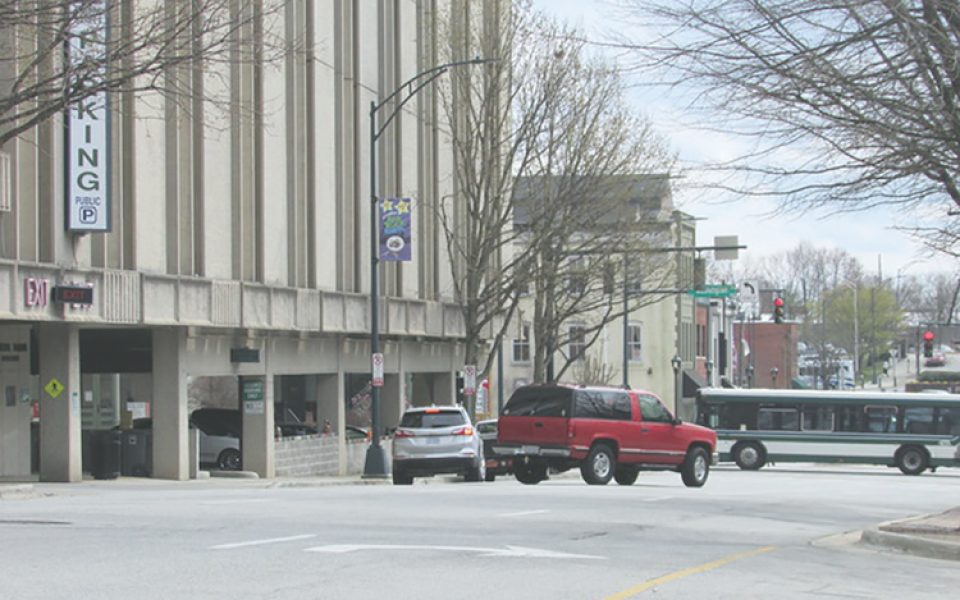In some respects, the two streets that flank Elm — Greene to the west and Davie to the east — are the service roads that support downtown Greensboro’s vital corridor: The pedestrian-friendly hum of commerce, dining, shopping and leisure that courses up and down Elm is made possible by a collection of back-end parking garages that allow auto-dependent visitors, workers and residents to come in and out of the center city with ease.
Greene Street in particular is designed for the convenience of people driving into downtown Greensboro who want to quickly park and get to their destination, with three south-bound lanes allowing drivers to turn into three parking decks that span as many blocks, including Lincoln Financial Group deck and two public decks. The result is a somewhat inhospitable stretch for pedestrians without much vibrancy, despite providing a front door for key institutions like city hall, the Guilford County Courthouse and Elon Law School.
As Greensboro cautiously embraces human-scale urbanism, the city is finally moving on a long-debated proposal to revert Greene Street back to a two-way street. Considering the goals of the BiPed Plan — adopted in 2015 — including investment in bicycling infrastructure, improving transportation “equity and choice” and increasing connectivity, one might assume that adding bike lanes to the revamped Greene Street would be a given.
That’s exactly what Bicycling In Greensboro is pushing for. To date, the nonprofit has collected 332 names on its petition to add bike lanes to Greene Street, including both online and hard copy, said Nicole Lindahl, project coordinator for Bicycling In Greensboro. According to Transportation Engineering Supervisor, online comments in favor of two-way conversion have outnumbered those opposed, 29 to 18. But even more commenters — 30 — “did not clearly support nor oppose the project but rather requested bike lanes, crosswalks, landscaping and traffic-calming enhancements,” she said.
Nicole Lindahl, who is also an employee of the Interactive Resource Center, pointed out to me that many of the homeless day center’s guests rely on bicycles for transportation. They frequently visit the courthouse to resolve misdemeanors, as well as the Family Justice Center, also located on Greene Street. It’s vital that one of the city’s most important streets serve all residents, she argues.
And it’s a matter of safety. Lindahl points to the city’s progress in bike-friendly infrastructure to argue for why continuing on that trajectory can make a real difference. She sold her car and bought a bike in 2004. At that time, many elected officials ridiculed the idea that Greensboro residents would want to transition from auto transportation to cycling. It wasn’t until 2007 that the city added the first bike lanes — on Spring Garden Street and Florida Street. From 2004 to 2010, Lindahl said she was hit six times by cars while riding her bike.
“I don’t want to jinx myself by saying this, but I haven’t been hit since that time,” she said. “I credit bike infrastructure and more people riding.
“It’s a completely different atmosphere than it used to be,” she adds. “This stuff works.”
Notwithstanding the city’s professed support for cycling, the current plan for Greene Street’s two-way conversion does not incorporate bike lanes. Instead of sacrificing one of the three traffic lanes, the plan calls for two southbound traffic lanes and one northbound lane.
The priorities of the parking garages are still driving the process. I haven’t found a city official who can give me a good explanation for why there’s a higher demand for traffic going southbound than northbound, other than force of habit from drivers being accustomed to using the current three southbound lanes. I’ve observed the 5 p.m. weekday rush as courthouse workers exit the Greene Street parking deck, while traversing three lanes to turn right onto Washington. It certainly provides a convenient access to North Edgeworth Street for those heading up Battleground Avenue to the northern suburbs, or to South Spring Street, for those headed south on Randleman Road. But when the two-way conversion takes place, they could just as easily drive up to Friendly Avenue and hang a left to catch either Edgeworth or Spring.
Councilwoman Marikay Abuzuaiter, who chairs the Greensboro Metro Planning Organization Transportation Advisory Committee, is sympathetic to the plea from Bicycling in Greensboro. But she told me that she doesn’t think it’s feasible to include bike lanes, at least in the crucial three-block stretch of Greene Street from Washington north to Friendly Avenue. But she said it might be possible to include bike lanes from Friendly Avenue north to Bellemeade Street.
Abuzuaiter said she’s focusing on getting bike lanes added to all feeder streets that bring people downtown, including North Elm Street from Fisher Avenue to Cone Boulevard.
Chris Spencer, the city’s traffic engineering manager, told me that city staff is concerned that narrowing Greene Street to two lanes would create an unacceptable level of congestion. Without a second southbound lane, he noted, traffic turning into the parking garages could bring traffic to a standstill.
Lindahl doesn’t disagree, but she asks why it’s a bad thing to slow down traffic.
“When you slow things down during rush hour, it makes things safer,” she said. “It’s almost like they’re choosing driver convenience over the safety of people.”
Join the First Amendment Society, a membership that goes directly to funding TCB‘s newsroom.
We believe that reporting can save the world.
The TCB First Amendment Society recognizes the vital role of a free, unfettered press with a bundling of local experiences designed to build community, and unique engagements with our newsroom that will help you understand, and shape, local journalism’s critical role in uplifting the people in our cities.
All revenue goes directly into the newsroom as reporters’ salaries and freelance commissions.


Leave a Reply